This book, which to me is a pleasure to present, is useful because it indicates or confirms once more, at which point it is now the progress of studies on a significant element in the Italian labor movement, the anarchist movement.
It may seem unusual to begin the presentation of a book by methodological, and then specialist and experts considerations. Nevertheless I think this is the heuristic point of view more interesting and wide, what makes the best interest of this study and its importance in defining the links with the work around him and the prospects that may arise.
Let me start, in these my brief remarks, a metaphor consistent with my always grown in parallel, a passion for art history. The history of the anarchist movement, practiced for a long time by many scholars with different instruments, from different angles, often driven by scientific passion and politics, is a fresco that is now revealed in its most complex and detailed subject.
Studies of a pioneering stage now distant, of which many will remember one of the main features of the instinctive flashes, the original ideas, the strong participation from which they had moved, had the merit of defining the scope of the work, to sketch the landscape, outline the profile and background.
For a long time the work of scholars then went on to refine this background, in defining the boundaries to make it clear to the stretches and warm to the characters that would house. Then, somehow knowingly and others thoughtlessly, some years ago prepared a phase change by almost all scholars who until then had worked on the fresco.
Missing, it is true, some of the pioneers and among the others noticed the lack of Pier Carlo Masini, who, as a great connoisseur of the libertarian movement, certainly had a central role in pointing the way forward and to inspire the work .
This phase change, reflecting its fundamental importance, after a few moments and parties failed attempts, needed several years to mature, but finally came true. When more than one hundred scholars and enthusiasts, gathered around the main research centers of the anarchist movement and in close conjunction with some universities, claiming a common and collective effort of over two years, managed to make the biographical dictionary of the Italian anarchists, passed , always remain in our metaphor, the representation, the beautiful background is now well established, the key characters of the fresco of the Italian anarchist movement.
I've written several times the importance of rebuilding and systematize the biographies of many leading figures and weave the web of their relationships around the central moments that have marked the evolution of history to which they belonged, and as the product of this hard work has finally allowed to restart a new course of history of anarchist movement.
I'm too modest, the authors of this study when they define their work "complementary " to that of the Dictionary, since in reality their work, as others focus on individual biographies that I was able to appreciate in this decade now passed since the project is national, in fact, not only continuing, but they give meaning to the dictionary and to the next phase of study, still open.
Between a phase in which the background, without which the protagonists would have floated in space, and leading figures themselves, we must apply ourselves collectively to insert figures seemingly minor, but in reality of substantial importance to continue in the fresco a movement as multifaceted as the original and anarchic.
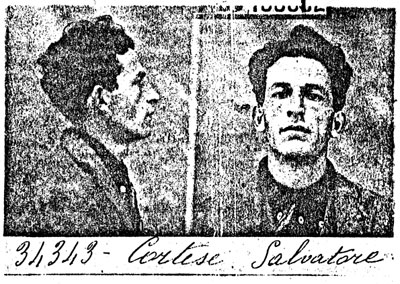
If the dictionary indicates a method of research, this paper applies it effectively and doing so allows you to draw around the twenty-four Calabrian contained in the earlier work, the chorus of five hundred anarchists who were filed during the reporting period.
The systematic work of excavation conducted by the authors, also allows you to connect the role of the former to the latter and in so doing, to articulate the various levels of a movement that, as has often been repeated, and by definition, escaping any rigid organization, grouped around flexible bonds so fragile as to be untouchable as are the personal ties in history. And by providing this new level of connection, it will restart a new weaving ties, relationships, experiences, places that can uncover a new part of the anarchist movement and, specifically, a new landscape, like that of an original region of Calabria.
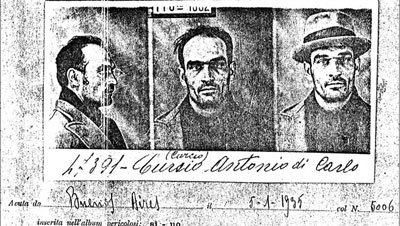
Here the identity of anarchism, as a species of the genus of the broader labor movement, spread in a difficult socio-economic context, "backward" we might say using the usual parameters of interpretation. Not surprisingly, much more than elsewhere, to reconstruct individual biographies of "militants" - what complexity in a term like this, especially if they returned to a territory and a society such as those examined - is to follow a path of emigration which, more elsewhere, is a journey in search of a decent life.
The original thrust of the rebellious individual, here, is not only more "individual" and elsewhere, the lack of an associative context of reference, but is perhaps even more difficult by the presence, or absence, of a fragile state and joints for 'existence of organizations much more "illegal" of lawlessness of workers and anarchy.
The history of the libertarian movement is strongly intertwined with social movements, but even more with the history of emigration is not linked to political reasons but for purely technical reasons of livelihood, and the figures are impressive in this regard.
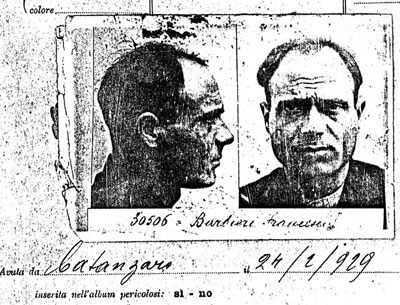
It is an interesting account, indeed, indicates that the politicization of the territory of instances and the start of bargaining organizations, associations and mutual benefit, just the return of "American" as an indirect result of emigration. Most of this has been a long, tortuous and painful process of the representation of the interests of subordinate classes conducted abroad, under the threat of repression who speak a foreign language in Argentina or the United States.
Finally, this book, puts in the fresco with the collective biographies of anarchists missing from Calabria, not an indistinct crowd but a clear set of individuals, and, once again, testifies to the many lives led, against all odds opposite men and events, to reaffirm its anarchic individuality, the need to protect everything from an ineradicable need for justice and a libertarian life.
 Maurizio Antonioli
Maurizio Antonioli
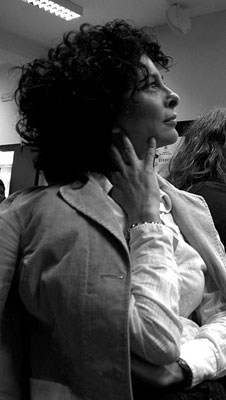 |
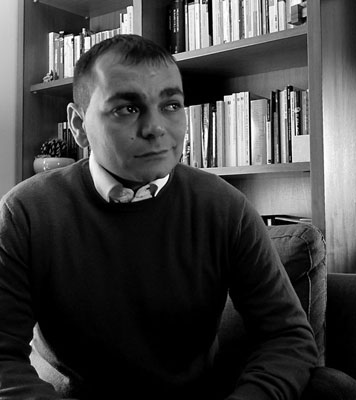 |
Katia Massara and Oscar Greco, editors of the Biographical dictionary
of Calabria anarchists.
|
The bios
of some anarchist members of Calabria
Trunzio, Carolina
Born in Cosenza July 9, 1858 by Giuseppe and Anna Maria Lista, a housewife-traders. In 1863, the age of five, lost her parents during a cholera epidemic and is reared by the family of Tito Zanardelli, professor of languages at the University of Bologna. By 1882 married in London the anarchist Eugenio (called Giovanni) Defendi and then binds to Errico Malatesta, from whom she had daughter Giulia, who was also later anarchist as well as her brother Enrico. The Italian authorities in London are starting to be interested in T. the early twentieth century. All her movements are carefully monitored by a police informer who, in the almost daily reports submitted, the signature "Virgil. " In late October of 1907 T. leaves to Paris to meet with her daughter - it seems - with a few fellow believers. Her will be a long journey, during which at least one occasion, is personally accompanied by Malatesta. The final destination is Bologna. Zanardelli, which would house the two women would have been unaware of the fact that T. and daughter had gone to town in order to make contact with fellow believers Italians to organize a conspiracy. On November 4, 1907, the prefect of Bologna note that the journey of T., so without a plausible reason, "arouses suspicion and apprehension. Therefore it is necessary to follow the moves of that woman and discover its intentions. "The same prefect, after a few days, reports that T. had not yet arrived Zanardelli home. Nevertheless, the next 14 confidant says: "The Defendi came to Bologna and then come to Rome. Will go to the Fabbri. So he wrote to her. It seems that the trip to Rome has been deemed necessary because Malatesta would have to be seen replicated calls to show himself there... seems to have been crafted with commitment to the task and that Malatesta is whether or not should be solved. From what I know, his coming will depend on what you will say the Defendi. On 18 November, the Ministry confirms that T. in Bologna: from there to London were received two letters. It is not clear however if it is hosted by Zanardelli, or if she does only deliver the mail in the home of his adoptive father. In December, however, is in Rome and at the end of the month or early January 1908 back to England. In later years hers political behavior is not overly concerned about the Italian authorities. Suffering from serious illness in 1915 was admitted to Italian hospital some time in London and in the summer of that year in a nursing home for alienated. She died in the capital March 17, 1919.
Sources: ACS, CPC, b. 5234, f. 109476, cc. 54, 1906-1910, 1915 and 1919.
Bibliography: DBAI, for vocem and I p. 498; Massara 2003, p. 73; Ead. 2007, pp. 283n and 290-291; R. Giulianelli (ed.), Luigi Fabbri, cit., pp. 59-60N.
Zanolli, Pia
Born in Belluno October 21, 1896 by Henry and Antoinette Recati, homewife-seamstress. Included in the list of dangerous subversives to be arrested in certain contingencies in the province of Reggio Calabria as the wife of the notorious anarchist Misefari Bruno, with whom she had been arrested in Domodossola (VB) in December 1919, she moved to Ponza in 1932 to reach the husband, sent into internal exile in the political settlement. Ignoring the place and date of death.
Sources: Acs, S13A, b. 11, f. RC 64, 1929-1932.
Bibliography: DBAI, II, pp. 191-192; Massara 2007, pp. 283n and 289.
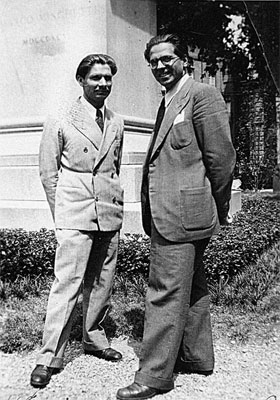 |
Florindo and Bruno Misefari |
Misefari, Bruno Vincenzo Francesco Attilio
Born in Palisades (Rc) January 17, 1892 by Carmelo and Francesca Autelitano, mining engineer-director of a glass factory. Brother of the anarchists Enzo and Florindo and student at the Technical Institute of Reggio Calabria, a boy, M. enrolled in the youth section of its town socialist party and contributes to the newspaper "the worker".
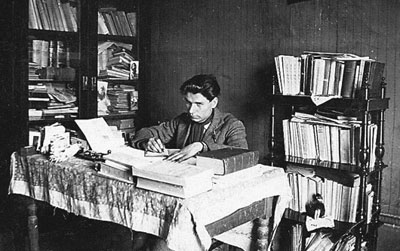 |
Florindo Misefari student |
In October 1911, during the Italo-turkish war, is denounced and condemned by the Court of Reggio Calabria - in its ruling of March 5, 1912 – to two and a half months'imprisonment for incitement to disobedience distributing antiwar leaflets to the conscripts of the 1891 class ; the ruling is upheld on appeal, the stay of execution of sentence for five years. On September 20, 1914 the anarchists of Ancona, with whom M. is in constant contact, have sent some anti-militarist prints, promptly seized by the police at the post office, in this period, moreover, maintains friendly relations with Renato Siglich. The surveillance against him intensifies. On the evening of March 5, 1916 and attends a social event, wearing the military uniform held a public speech against war and militarism, the day after he deserts. On 31 March after he was arrested while attempting to cross the border under the assumed name of Diego De Tommasi, and conducted in Naples immediately available to the military court. Infantry, returned to the storage of Benevento, thereby resulting in the suspension of criminal proceedings against him, on August 25 of that year abandoned again the army, and was immediately reported in the Bulletin of the research and identified in Switzerland, in Zurich - where lived under the assumed name Furio Sbarnemi - until September 1917. He joined the local anarchist circle gathered around the international bookstore, M. published in the newspaper 'The Awakening' in Geneva an article entitled The situation in Italy, where he describes the political and social plight of the country.
Suspected of being an agent of the Bolshevik propaganda and referred to as bitter political enemy of Francesco Misiano (with who M. actually maintain relations of friendship), in the spring of 1918 was arrested by federal police, along with Luigi Bertoni, Carlo Castagna, Ugo Fedeli, Francesco Ghezzi, Giuseppe Monanni and other Italian comrades, following the discovery of a suspected anarchist conspiracy, and in December of that year was expelled from Switzerland on charges of being an agent of Lenin. He took refuge first in Germany (in Berlin will be in touch with fellow Neapolitan Oreste Abbate), in November 1919 he was arrested in Domodossola and detained as he attempted to return to Italy. On 11 December following the deputy Interior Minister Francesco Misiano sends the following telegram: " It results to me that deserter Bruno Misefari arbitrarily arrested late November the border while returning to Italy after the amnesty. Even now he is held Domodossola stop, please provide termination will local authorities”. Released after a few days, M. is then returned to Reggio Calabria and continues to play political propaganda through conferences and meetings - as well as in its region - also in Puglia and Campania. In 1921 defended Giuseppe Imondi from the charge of espionage after a serious battle with the bordighiani Communists from Campania; because of this contrast, along with Imondi and his partner, Maria Berardi, will be removed from the Chamber of Labour of Naples. In February 1922, for example, together with Roberto Elias calls for the publication of the newspaper "bread and freedom", which was to spread the anarchist ideal in Calabria, using also written in dialect, but the project does not take off due to lack of funding. He graduated in engineering in December 1924 began the publication of the fortnightly anarchist "The friend of the people ", whom he also works as a director and a fellow believer and friend Antonio Malara. The monitoring is very close to him, especially after the promulgation of exceptional laws. In December 1926 he was cautioned and asked to refrain from any political activity intended to overturn national laws, but instead he continues to profess their own ideas and keep in touch with the Swiss libertarian groups that were following Bertoni, in this period is also included in a list of dangerous people to be arrested in certain contingencies. In the meantime, he ran a glass factory in Villa San Giovanni (Rc) together with former deputy of the People's Party Nicola Siles and began to devote resources to the use of silica, without ever forgetting the political commitment.
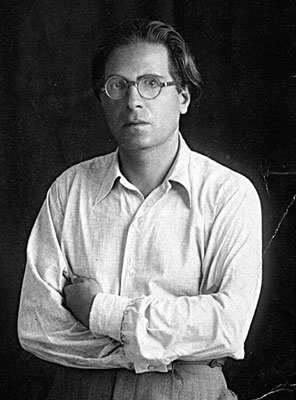 |
Bruno Misefari a Ponza |
On 20 March 1931, at the funeral of his friend, the industrialist Joseph Zagarella, M. gave a speech in which, extolling the qualities of kindness and generosity of the deceased, by contrast, describes the society of the time as a place of violence, corruption and injustice, "a deserted land, in which larvae of men not men, armed with poisons and daggers, corruption and betrayal, chase and fight, is torturing and killing each other: the infernal pit of mud and blood, echoing cries of cats winners and gasps of losers, the tears of children, the laments of mothers and sobs of the old. "The police sees in a speech an anarchist inspiration, so the next 25 M. is arrested and assigned to confinement for two years from Cp of Reggio Calabria, by order of April 14. Intended to Ponza, May 28 wedding in a civil ceremony Pia Zanolli, the companion that is beside the days of the period from Geneva. On April 16, 1932 Court of Appeal which dismissed the action with the M. had tried to explain the real causes of the measure, as determined in his opinion the intention of excluding it from the board of the "glass companies Calabrese”, of which the deceased Zagarella had been president, November 12 is released on the occasion of the next decade. He moved to Davoli (CZ), yet he still has many obstacles to the realization of his projects in the extractive industries sector. He died in Rome, after a serious illness, June 12, 1936. His wife is not allowed to be shown on the tombstone the following inscription, composed by the same M.: "It's the deep night far less severe than that to tell me he showed cowardice and sheepness strong populace of slaves. Far from crying here: I am well with the dead. "
Sources: Acs, Cp, b. 676, cc. 253, 1931-1933, CPC, b. 3313, f. 89050, ff. 638 plus a copy of the newspaper 'Freedom' of December 21, 1933, 1910-1937, S13A, b. 11, f. RC 65, 1929-1930 and 1933.
Bibliography: DBAI, for vocem and I, pp. 3, 162 and 549, II pp. 4, 56, 234, 437, 551 and 561;, "Mankind Nova 'on 21 June 1953, July 26, 1959, June 1, 1961, 1, 22 and 29 June 1986 Coal 1989 to vocem; Massara 2003, pp. 69-70, 82-83 and 85.
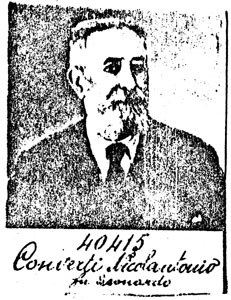 Converti, Nicolantonio Converti, Nicolantonio
Born in Roseto Capo Spulico (Cs) March 18, 1855 (or March 16, 1858) by Leonardo and Isabella Allotta (or Elizabetta Aletta), medicine. At eighteen, Baccalaureate, he enrolled at the university in Naples, where he attended lectures in philosophy of law of Giovanni Bovio, which give way to deepen their anarcho-socialist principles. In Naples, met Francesco Saverio Merlino (with whom, along with John Domanico, Luigi Felici and Giuseppe Sarno gives rise to a series of publications, including the periodical "The Social Movement”) and begins a correspondence with Giuseppe De Felice Giuffrida, becoming a prominent element of the International. In 1881 he was warned by the magistrate of Amendolara (Cs) as an internationalist. When in 1885 he moved to Florence to continue his studies, he intensified his political activities. Sentenced in absentia to twenty months imprisonment for press offenses, clandestinely embarks in Livorno to Bastia to escape the police, moving then to Nice and Marseille. Finally he moved to Paris and then in Tunis, where he graduated in medicine. Meanwhile, the Court of Palermo, Judgement of 29 November 1890, sentenced him in absentia to three months in prison and a fine of 100 lire for press offenses, having released his famous pamphlet of anarchist character. A friend of Andrea Costa and the author of several books (among which the Republic and anarchy, which is its most significant theoretical contribution) and numerous writings published in various magazines including the libertarian "The Masaniello, " C. heads for some time the paper "Il Piccone" - of which he became for a time, along with Gaetano Combatti-Lentini and Pasquale Pensa, the chief editor - and is also the founder of the newspaper "La Protesta Umana", "L’Operaio" (defined the body of anarchists in Tunis and Sicily) and "The International anarchiste", whose first issue comes out October 16, 1886, and in particular, address the criticism of the republican system, in addition, together with Gaetano Grassi, takes the lead of the periodical "Lo Schiavo" of Nice. The speculative effort, moreover, not away from active militancy: in 1896, together with fellow believers Alberto Giannitrapani and Giuseppe Patti arranges the escape from the colony of Favignana (TP) of some convicts including Giovanni Bergamasco, Olinto Fibbi, Galileo Palla and Francesco Pezzi. On April 16, 1913 in Roseto and back, caused a sensation in the anarchic environment, is a candidate, he offers a program anarcho-communist, in the college of Cassano Jonio, taking on 1 May of that year, a conference on the occasion of Labor Day. Back in Africa, seems to devote himself to family and profession. It is one of the founders of some relief organizations such as the "Green Cross" and medical care and the Italian Hospital G. Garibaldi of Tunis, where he served as a doctor at night and under conditions very modest and from whose director is considered an idealist not dangerous. In fact, it's C. is a leading figure in the anarchist colony in Tunis and maintains close ties with fellow considered rather dangerous, as Antonio Azzaretti, Luigi Damiani and Gino Bibbi. On December 17, 1931 writes an article on "La Voce Nuova" in Tunis to commemorate the late Luigi Galleani. Meanwhile, with notes of March 25, 1931 and 4 February 1932, the Italian consul reports him as an anarchist militant and uncompromising in his revolutionary ideas. In fact, while remaining seemingly secluded, C. is always in relation with known libertarians and anti-fascists of Tunis, the French leaders of Freemasonry, the Socialist Party (SFIO) and Lidu, as well as being subversive correspondence with other residents in France and America, including the famous anarchist Paolo Schicchi. Upon arrival in Tunis, for example, goes to greet the well-known Léon Jonhaux and Bruno Buozzi, with whom he had frequent contacts. In a telegram of January 12, 1933 is communicated to all the prefects of the kingdom that the militant anarchist C. would probably have gone to Italy equipped with a regular passport with unspecified duties, he also would have been funded by anarchist organizations in Paris and that, therefore, had to be provided careful monitoring measures. On 9 June of that year is reported that his son Ernesto, also of feelings anarchists and part of the Lidu, which published an article titled “Tribuna Libera” on the newspaper “La Voce Nuova”, and another son named Gustavo Florian was friendly relations with the Bibbi. C. On January 12, 1934 action, along with Bibbi, Vella and many others, at the funeral of Sicilian anti- fascist Erminio Grassi held in Tunis. In September 1935, founded together with Damiani, Antonio Casubolo and Vincenzo Mazzone, the weekly anarchist in Italian "Il Domani" and - always in those days - commemorates the companion Metello Evangelisti – who died Aug. 25 - with a real defense of the principles anarchists. On 14 August, despite his age, he participated in the event Gametta Park in favor of the Spanish Popular Front, speaking and claiming to have confidence in a better future for humanity regenerated and more fraternal. In 1938 he was again reported from Tunis, where he has been an important center of libertarian propaganda and continues to express subversive ideas. He died in the Tunisian capital September 14, 1939. At his funeral were present all the anarchists in the city, a delegation of Lidu and a group of well-known anti-fascists.
Sources: ACS, CPC, b. 1460, f. 48613, ff. 89, 1894, 1913 and 1928-1939.
Bibliography: DBAI, for vocem and PP. 17, 62, 98, 181, 275, 375, 428, 461, 484, 618, 710 and 760, II pp. 71, 135, 162, 235 and 514; "Almacco libertarian, " 1940-1941, "will", n. 10, 1960; P.F. Buccellato, M. Iaccio, anarchists in southern ..., cit., Rome, Bulzoni 1982, pp. 264n, 298-300, 308, 317n, 319-320, 330 and 332; G. Galzerano, Vincenzo Perrone, Casal Velino Scalo (SA), Galzerano 1999, p. 227; surface level Masini, History of Italian anarchists from Bakunin a Malatesta (1862-1892), Bologna, BUR, 1974, p. 221; Massara 2003, pp. 74-75; E. Santarelli, The social anarchism in Italy, Milan, Feltrinelli, 1959, p. 182; G. Sun, The origins of socialism in Cosenza (1860-1880), Cosenza, Brenner 1981, pp. 139-140, 161 and 173-174.
|

